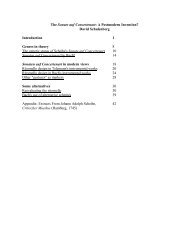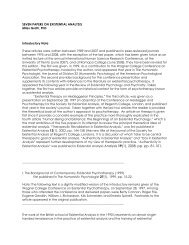A Bach Manuscript Recovered: Berlin, Bibliothek der Hochschule ...
A Bach Manuscript Recovered: Berlin, Bibliothek der Hochschule ...
A Bach Manuscript Recovered: Berlin, Bibliothek der Hochschule ...
You also want an ePaper? Increase the reach of your titles
YUMPU automatically turns print PDFs into web optimized ePapers that Google loves.
5<br />
Listed in Wolff, “From <strong>Berlin</strong> to Lodz,” 326.<br />
A <strong>Bach</strong> <strong>Manuscript</strong> <strong>Recovered</strong>, p. 2<br />
the Montreal book dealer H. E. Heinemann; he also stated that Heinemann and his wife, a dentist,<br />
had been Jews who had fled Germany to Canada via China. The invoice is undated, and Manson<br />
was uncertain of the exact date of the acquisition, but his typed inventory of the manuscript is<br />
dated June 1954. Heinemann's Mansfield Book Mart no longer exists, and Manson did not know<br />
how Heinemann had come into possession of the manuscript. Thus the present discovery<br />
unfortunately does not seem to furnish any clues to the location of other missing Spitta<br />
materials. 5<br />
Although this is not the place for a detailed inventory or study of the manuscript, a brief<br />
description of the contents may be appropriate inasmuch as it has remained hidden for so long<br />
6<br />
from scholars. In its present state, the opening section (pp. 1–44) containing forty-four chorale<br />
preludes by Johann Christoph <strong>Bach</strong> is followed by a second group (pp. 45–65) of chorale<br />
preludes anonymous save for two attributions to “J. D. F.” A number of pieces in this section, as<br />
in later sections, contain indications for registration and the like. Several subsequent gatherings<br />
containing chorales, now separate but perhaps originally constituting a single unit, include<br />
attributions to:<br />
“Mons. Fiedl”<br />
“J. D. Fiedl”<br />
“W. C. B.”—the Gotha capellmeister Wolfgang Carl Briegel (1626–1712)?<br />
J. S. <strong>Bach</strong>;<br />
Johann Pachelbel;<br />
“Witte”—Christian Friedrich Witt?<br />
J. D. Scheidler—the Gotha cellist Johann David Scheidler (1748–1802), father-in-law of<br />
Spohr?<br />
“J. Buttstedt”<br />
“J.G. Rausch”—supplemented in pencil as “Reuch,” perhaps the Strasbourg organist Johann<br />
Georg Rauch (d. 1710) or his son of the same name (1702–79)<br />
and “J.R.”<br />
Interrupting the series of chorales are several apparently pedagogical pieces, the first bearing the<br />
name “Bergman,” presumably Adolph Gottfried Bergman (1740–1807), organist at Mühlhausen,<br />
or Andreas, organist in 1778 at Trier (pp. 74–90). These are followed by a section that has the<br />
appearance of a notebook or sketchbook used by one or more students (pp. 91–120); here are<br />
found passages in figured bass notation (many fully or partially realized), including what appear<br />
to be exemplary progressions, partimento fugues, and the like. One little ten-bar piece is signed<br />
“D. Haueize” or the like (p. 97; the script is not entirely clear), calling to mind the Frankfurt<br />
organist and publisher Wolfgang (Wilhelm) Nicolaus Haueisen (1740–1804). The style here is<br />
that of the late eighteenth or early nineteenth century; several hands appear to be present.<br />
6<br />
A microfilm of the manuscript in the New York Public Library was first listed in the 1972 supplement to<br />
the library's published catalogue; the source of the film and the story of its acquisition remain to be investigated.















